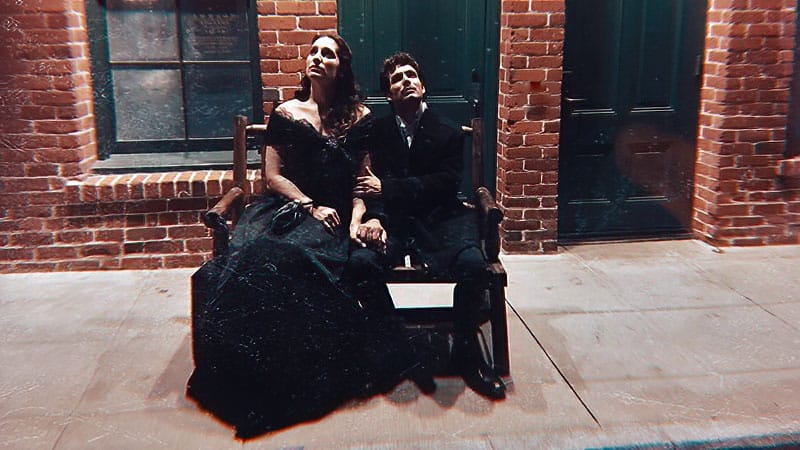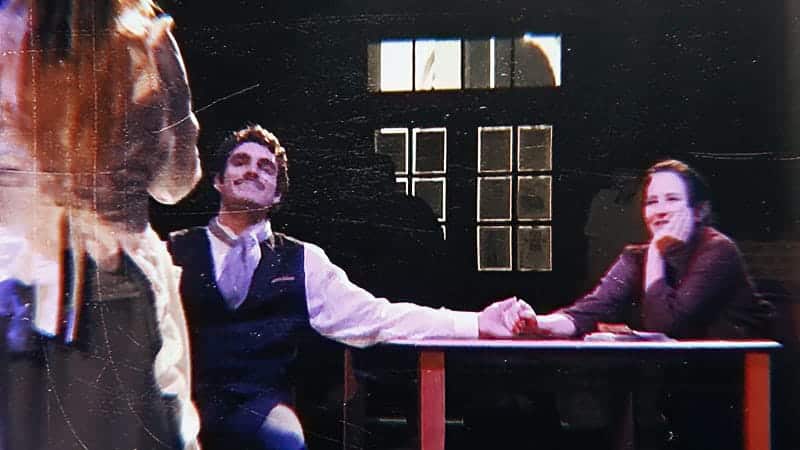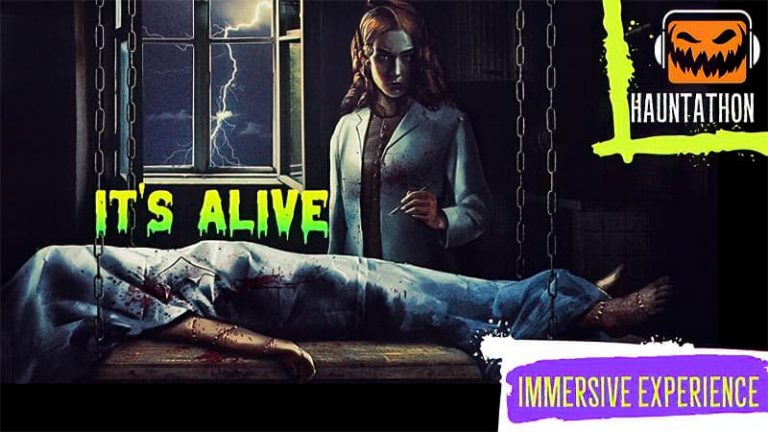“I didn't know what to expect, but it was amazing the one-on-one interaction and how they moved you around, and I just kept you intrigued. It was like, what, what next?”
“It's more entertaining than the New York Knicks. That's for sure.”
These guests are talking about, It’s Alive, a new Frankenstein immersive experience. On day 12 of our 61 day Hauntathon, counting down to Halloween, we’re on location at It’s Alive to find out what the show is like by talking to Devon Armstrong, director and co-writer for It’s Alive.
Listen Here
Devon Explains, What is It’s Alive?
“It’s Alive is a show about Mary Shelley. She had many poets and friends in her life, all of whom died, pretty tragically and horribly. In this show, Mary is going to ask you to help her take their body parts [of her friends] and sew them together into a grief monster that she brings back to life and faces down. You’re very much a part of that process, so you might be asked to maybe dig up a grave, or you might be asked to hold someone’s tongue in your hand and sew it into something, but it’s an individual experience. So expect to be broken up from the people you came with. Expect all sorts of different experiences than they had, and you may get a one-on-one scene with an actor who may give you a gift,” explains Devon Armstrong.
“All this began as a dare, a challenge. Byron, Polidori, Mary and her husband, Shelley would write a ghost story. Mary’s became a book, very acclaimed. The first impulse for her book came to her in a dream. She saw in the moonlight flooding through her room a phantasm of a man being brought to life by the workings of some powerful machine.
This, Mary Shelley, my creator. A young woman with a ravenous intellect and untamed imagination We will trespass on her consciousness, eavesdrop on her memories. You will come to know her as I have. Perhaps through her, you will come to know yourself.”

How Did Devon Come Up With And Write It’s Alive?
“When you approach a show like this, knowing that the audience is not going to have a linear experience, we aimed for a thematic experience. So, everybody has a different piece of the story. You can’t say, “it’s A, B, C, and follows like that.” Instead, we picked a theme. We decided to write about Mary Shelley. Last time we did Edgar Allen Poe, and this time, we decided to write about Mary Shelley.
We’ve found that the most fascinating aspect of Mary Shelley’s life was this amazing literary circle that she basically created and was such a central part of. I co-wrote the play with my dad actually, and then we said, “okay, where’s the story in this?” We started realizing that she was sort of, slowly over the course of her life, left alone and all of these amazing, fascinating people died and left her. Then we drew that parallel to Frankenstein. Like, what would happen if Mary took all these people she was in love with and took their body parts and made them into a monster that she brought back?”
“Are you sure you want this?”
“Yes.”
“I have assembled what you asked. Have you thought this through?”
“The time for thinking is over. This is the final piece, I know where it must go.”
“Be careful Mary.”
“So every character in every different scene addresses that theme on some level with you, the audience member, and then you have just this sort of, barely like skeleton frame of a play on the outside of that, that everybody gets to see so they can understand something overall about where the story goes.”

How Did Devon Find The Through-Line To Maintain Coherency?
“There are three scenes that everybody sees. There’s 22 people per performance, although what the audience doesn’t know is that those 22 people are actually broken into 11 and 11, so in essence, it’s really an 11 person show, that way we’ll be able to pay special attention and keep all the scenes intimate and small. It’s not actually set in stone, so it’s not like, you know, person one, person two, person three, or whatever, it is largely up to the actors and how they see you and how they choose to grab onto you and take you, pull you off for one-on-one or something like that.”
This Is An Entirely New Script, Not A Frankenstein Rewrite
“Whenever we come into writing something or telling this story, it’s funny where you start and what takes you by surprise. I think we came in intending to write a scary story about Frankenstein and accidentally ended up discovering this whole crazy, amazing world, and that just sort of stole us. That was what was fascinating to us. We were like, “wait a minute, the original vampire story and Frankenstein, and Frank Byron’s Fragment all came from one night in Lake Geneva? Okay, that’s our story.” So that’s what we chose to focus on. Then of course there was like that metaphysical aspect of, “okay, we want it to get inside Mary’s head, and then marry those two things together.” Like the story of Frankenstein itself and the story of the creation of it and her loved ones.
Basically, we started researching and the story just sorta ran away with itself and pulled us in that direction, and that’s how we ended up with what we ended up with. All of the characters were real people, they all died how have they died in the play, except for Victor who makes his way out of Frankenstein and is sort of Mary’s voice in her head.
As a company that goes into spaces like this, we want to pick something that’s right for this space, and it showed us something about Mary that we didn’t know before, which was her, not just that she wrote Frankenstein, but this rebellious, outlaw, literary genius. Shelley died and his work was just a mess and she put it all together and gave us the poems that we have now. Found out that she edited as much of his work as he did of hers, that they had this amazing literary connection and that drove it.
Check out, Romantic Outlaws, and then there’s also the Young Romantics, which is another book that we used as our source material. Then of course, Mary’s notes when she was traveling.
Polidori’s notes when he was spying on Byron. Byron’s Childe Harold’s Pilgramage, the poetry itself, and just sort of like researching the crap out of everything and then narrowing down to us to find that story in there. Not just Frankenstein, but this world, how she made it happen, how it inspired her to make it happen.”

This Is Downtown Repertory Theater's Second Script Written From Scratch
“We started in a parking structure in downtown LA. We’d never actually been in a theater. And in the beginning that was budgetary. We had no money. So, we our first show we were in a parking lot. So, we lit it with car headlights, and we played the sound cues through the car radios, and that’s where we started. We’re still not a big theater company financially, and everything like that, it’s very much passion projects kind of thing. We had been doing a lot of classical stuff because you don’t have to pay for the rights, and we had been doing a lot of, you know, in-the-park presentation style things, and everything like that. But, we finally decided that we should take a leap at making our own material, and that’s where our first sort of major play The Assassination of Edgar Allen Poe came from. It really took us off guard how into it people were.”
“This is by far the most challenging play I’ve ever directed. You have to challenge yourself as much as humanly possible in order to rise to that challenge, artistically. The more creative and insane you get, the better you get at problem solving for that insanity and the cooler weirder crazier thing you can make for an audience. It’s scary, and it’s difficult, and it’s hard, and every time we go into this, I feel sick. Like pretty much half the time I’m putting the show together. I’m like, it’s not going to work, until it does. There’s something magic about theater.”
Guest Impressions of It’s Alive
“When it said interactive, that sold me. I don’t like to necessarily just sit there and, you know, have people just talk at you. The walking, the experiencing, I mean, even the touching, don’t be worried about the touching, it’s, I mean, they don’t do too much of it, but just that personal, you know, sort of feel to it is what makes it different than anything.”
“Oh, for me, it’s like, you’re like, you’re part of the movie. It’s like, you’re in it instead of just watching you’re actually in it, it is just amazing. And like these, these performers are amazing, how they remember the scenes. Oh my goodness, I don’t know how they do it.”
Guest’s Most Memorable Character In It’s Alive
“One of the sisters, it was actually her and I just together, she goes to the back, and she pulled her eyes out and she handed them over to me. So that was really cool. Yeah.”
“That’s pretty cool. I didn’t get to experience that. So, it depends, you know, the night that you come, you get to experience something different. So that’s pretty awesome.”
“Definitely the blindfolding. I’m not very good when my senses get taken away and touching of unknown substances was definitely a line that I wasn’t really sure I was going to cross, but I’m trying to get in on the experience.”
“What caught me off guard was it just felt like I was part of the show because like, these actors were actually. Asking me questions. They were saying, “Hey, come along with me.” So, they literally take you along on the ride with them, you know?”

It’s Alive Has Been Extended Through October, And Is Getting A New Location
We are moving [It’s Alive] up to Altadena Mausoleum at Mountain View Cemetery. So, we’re very excited to do the show up there and for the entire month of October. So, from October 1st to October 30 we have 20 performances. We’re stoked. It’s our first time up there, and it’s a really, really cool spot. It’s going to change the show completely. It’s going to make the show much more like metaphorical inside Mary’s head.
So this really is going to take place firmly inside Mary’s head, and we’re going to have to adapt the play to meet the standards of the new space. For instance, at this museum, we have realistic sets with a realistic tables and chairs and clocks and paintings. And the mausoleum, there’s nothing but marble, long marble hallways that echo like crazy. And the actors have been saying, what’s going to happen? Are we going to hear each other yelling from other rooms? Isn’t it going to echo?
There’s a saying with my theater company from the start, if you can’t fix it, feature it. That’s been like our motto all along, right? If you’re in a parking structure, don’t build a theater in a parking structure, light the show with cars, use the car radios to play the music, drive cars on stage and have actors get out of the cars and start their scene. Cause you can’t fix it, so make it part of it.
So, what we’re going to do in the mausoleum, embrace that echo. When the cast is talking to each other and they hear those yells down the hall, now we’re really firmly inside Mary’s imagination, inside Mary’s head. So, we’re just going to embrace that environment, and it’s like the screams of the other people that are like what’s echoing through her mind.
Visit It’s Alive!
Please check out the show, or visit our website to learn more. We’re stoked to see you. Come see and experience, hopefully, something you’ve never seen before, take you out of your element and find something new.

